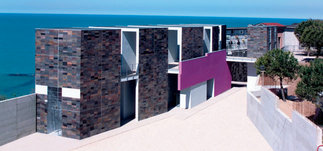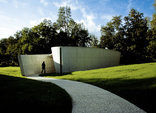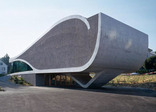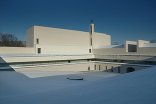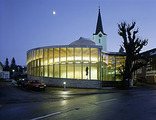Bauwerk
Ortona Cementery
Giovanni Vaccarini - Ortona (I) - 2006

Cemetery, Ortona
Giovanni Vaccarini has connected space and time, geometry and landscape.
15. November 2006 - Daria Ricchi
„Acemetery is not a grave, it is a form of relationship with landscape and oblivion.“ With these words Enric Miralles explained his design for the Igualada Cemetery. Indeed, the concept of a grave is fundamentally different from the concept of a cemetery. A cemetery complex is not only a place for commemoration, a transit place for brief visits, but also a place for pausing and reflecting. Thus, planning a cemetery means planning both its own space and its disposition in space.
Giovanni Vaccarini believes that „architecture originates from ideas, not from form; form is only a byproduct of ideas“. The main idea behind this project is the commemoration of thousands of victims of World WarI. Ortona Cemetery is located near another, Canadian, war cemetery. The project envisaged the extension of the existing complex by incorporating the last undeveloped area on the far north side of the cemetery perimeter. The cemetery is located on a hillside, facing the sea and overlooking an extraordinary landscape. Vaccarini completed the cemetery complex by adding the final element, visible from both land and sea.
The 280 new recesses are organized, like the old ones, in parallel lines. The funerary buildings are inserted between the lines in a comb pattern. One line, perpendicular to the rest, marks the periphery of the complex on the sea side. The 109 side chapels (with the same number of recesses) run along this side of the complex, covering a surface area of some 3000 square metres.
Vaccarini is used to playing with simple, primary forms and architectural elements in the pursuit of linearity. Linear geometry is once again the key to understanding this project. Volume is used to define space and the disposition of the different elements in space. The buildings containing the recesses are two-storey blocks in the shape of a parallelepiped. In order to avoid a monolithic or monotonous look, the architect alternated the closed volumes with open spaces, which makes the complex considerably lighter.
The open spaces at times coincide with the organization of circulation in the cemetery. The distinction between social space and circulation space is highlighted not only by using different volumes and surfaces, but also by employing different building mater-ials. The first are enclosed in volumes built in hard materials, the latter are plastered in an unusual pink colour for the stairs leading to the upper level, and white for the corridors.
Every time the wall is interrupted by a path or empty space, it provides a view towards the sea. Redefining space and the relationship between space and landscape, the project creates a sequence of scenic frames that capture the landscape and invite the visitor to pause. Conversely, for those looking at it from the sea, the cemetery appears as a stronghold, thanks in no small part to the use of local limestone in different colours and shades.
One might compare it to the Brion Cemetery complex, realized by Carlo Scarpa (1970-1975), where the perception of space and nature is also overwhelming and where the memory of the function of the place is lost, yielding to contemplation. Or it could be compared to Modena Cemetery, designed by Aldo Rossi, where the buildings „become a city“ in a highly dramatic sense. The cemetery thus remains a thoughtful public space, with a clear organization and a rational use of land.
Vaccarini is a typical representative of the Pescara school, which, although still young in tradition and small in scale, is producing fine works which are appreciated for their grace and discretion. It is a „sottovoce“ in the loud choir of contemporary architecture.
Giovanni Vaccarini believes that „architecture originates from ideas, not from form; form is only a byproduct of ideas“. The main idea behind this project is the commemoration of thousands of victims of World WarI. Ortona Cemetery is located near another, Canadian, war cemetery. The project envisaged the extension of the existing complex by incorporating the last undeveloped area on the far north side of the cemetery perimeter. The cemetery is located on a hillside, facing the sea and overlooking an extraordinary landscape. Vaccarini completed the cemetery complex by adding the final element, visible from both land and sea.
The 280 new recesses are organized, like the old ones, in parallel lines. The funerary buildings are inserted between the lines in a comb pattern. One line, perpendicular to the rest, marks the periphery of the complex on the sea side. The 109 side chapels (with the same number of recesses) run along this side of the complex, covering a surface area of some 3000 square metres.
Vaccarini is used to playing with simple, primary forms and architectural elements in the pursuit of linearity. Linear geometry is once again the key to understanding this project. Volume is used to define space and the disposition of the different elements in space. The buildings containing the recesses are two-storey blocks in the shape of a parallelepiped. In order to avoid a monolithic or monotonous look, the architect alternated the closed volumes with open spaces, which makes the complex considerably lighter.
The open spaces at times coincide with the organization of circulation in the cemetery. The distinction between social space and circulation space is highlighted not only by using different volumes and surfaces, but also by employing different building mater-ials. The first are enclosed in volumes built in hard materials, the latter are plastered in an unusual pink colour for the stairs leading to the upper level, and white for the corridors.
Every time the wall is interrupted by a path or empty space, it provides a view towards the sea. Redefining space and the relationship between space and landscape, the project creates a sequence of scenic frames that capture the landscape and invite the visitor to pause. Conversely, for those looking at it from the sea, the cemetery appears as a stronghold, thanks in no small part to the use of local limestone in different colours and shades.
One might compare it to the Brion Cemetery complex, realized by Carlo Scarpa (1970-1975), where the perception of space and nature is also overwhelming and where the memory of the function of the place is lost, yielding to contemplation. Or it could be compared to Modena Cemetery, designed by Aldo Rossi, where the buildings „become a city“ in a highly dramatic sense. The cemetery thus remains a thoughtful public space, with a clear organization and a rational use of land.
Vaccarini is a typical representative of the Pescara school, which, although still young in tradition and small in scale, is producing fine works which are appreciated for their grace and discretion. It is a „sottovoce“ in the loud choir of contemporary architecture.
Für den Beitrag verantwortlich: A10
Ansprechpartner:in für diese Seite: Hans Ibelings
Akteure
ArchitekturBauherrschaft
Amministratore comunale Ortona
Fotografie
